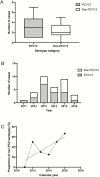Hospital-based Surveillance Provides Insights Into the Etiology of Pediatric Bacterial Meningitis in Yaoundé, Cameroon, in the Post-Vaccine Era
- PMID: 31505633
- PMCID: PMC6761319
- DOI: 10.1093/cid/ciz506
Hospital-based Surveillance Provides Insights Into the Etiology of Pediatric Bacterial Meningitis in Yaoundé, Cameroon, in the Post-Vaccine Era
Abstract
Background: Meningitis is endemic to regions of Cameroon outside the meningitis belt including the capital city, Yaoundé. Through surveillance, we studied the etiology and molecular epidemiology of pediatric bacterial meningitis in Yaoundé from 2010 to 2016.
Methods: Lumbar puncture was performed on 5958 suspected meningitis cases; 765 specimens were further tested by culture, latex agglutination, and/or polymerase chain reaction (PCR). Serotyping/grouping, antimicrobial susceptibility testing, and/or whole genome sequencing were performed where applicable.
Results: The leading pathogens detected among the 126 confirmed cases were Streptococcus pneumoniae (93 [73.8%]), Haemophilus influenzae (18 [14.3%]), and Neisseria meningitidis (15 [11.9%]). We identified more vaccine serotypes (19 [61%]) than nonvaccine serotypes (12 [39%]); however, in the latter years non-pneumococcal conjugate vaccine serotypes were more common. Whole genome data on 29 S. pneumoniae isolates identified related strains (<30 single-nucleotide polymorphism difference). All but 1 of the genomes harbored a resistance genotype to at least 1 antibiotic, and vaccine serotypes harbored more resistance genes than nonvaccine serotypes (P < .05). Of 9 cases of H. influenzae, 8 were type b (Hib) and 1 was type f. However, the cases of Hib were either in unvaccinated individuals or children who had not yet received all 3 doses. We were unable to serogroup the N. meningitidis cases by PCR.
Conclusions: Streptococcus pneumoniae remains a leading cause of pediatric bacterial meningitis, and nonvaccine serotypes may play a bigger role in disease etiology in the postvaccine era. There is evidence of Hib disease among children in Cameroon, which warrants further investigation.
Keywords: conjugate vaccine; genotyping; pediatric bacterial meningitis.
© The Author(s) 2019. Published by Oxford University Press for the Infectious Diseases Society of America. All rights reserved. For permissions, e-mail: journals.permissions@oup.com.
Figures




References
-
- Oostenbrink R, Maas M, Moons KG, Moll HA. Sequelae after bacterial meningitis in childhood. Scand J Infect Dis 2002; 34:379–82. - PubMed
-
- Fonkoua MC, Cunin P, Sorlin P, Musi J, Martin PM. Bacterial meningitis in Yaoundé (Cameroon) in 1999–2000 [in French]. Bull Soc Pathol Exot 2001; 94:300–03. - PubMed
-
- Nguefack S, Chiabi A, Enoh J; EMOJ Etiologies and outcome of children with purulent meningitis at the Yaounde Gyneco-Obstetric and Pediatric Hospital (Cameroon). Open J Pediatr 2014; 4:269–75.
-
- World Health Organization/UNICEF. WHO vaccine-preventable diseases: monitoring system. 2018 global summary. WHO UNICEF estimates time series for Cameroon. Geneva, Switzerland: WHO, 2018. Available at: http://apps.who.int/immunization_monitoring/globalsummary/estimates?c=CMR. Accessed December 2018.
Publication types
MeSH terms
Substances
LinkOut - more resources
Full Text Sources
Medical

